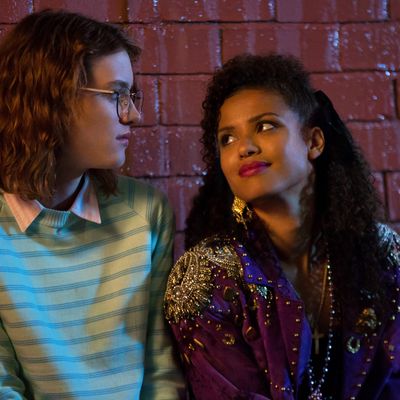
Spoilers ahead for the “San Junipero” episode of Black Mirror.
In the Black Mirror universe, technology is generally depicted as a force that will crush your soul, when it doesn’t actually kill you. Grainlike cameras implanted behind people’s ears tear apart their marriages. The wrong Twitter hashtag next to your name could lead to your execution by an angry mob. So San Junipero, the fourth episode in the new season, out this month on Netflix, came as a welcome relief, a warm bath of love and ‘80s music. It’s about two lonely women who, thanks to the wonders of technology, find true love and live happily ever after. Naturally, this episode has left people wondering whether such a future is possible. Could little nodes attached to our heads one day allow us to spend the afterlife in a picture-perfect virtual-reality beach town?
Vulture caught up with Michael Hendricks, neuroscientist and assistant professor of biology at McGill University and author of an excellent and somewhat controversial article in the MIT Technology Review where he compares cryonics to snake oil. Below, Hendricks breaks down the nuances of the episode, the technology required to pull such a vision off, and the haunting ending, which may or may not be so happy after all.
What did you think of the episode?
I loved the episode — I loved the story. I was expecting it to go darker, given the show, but no. Though I did think there were dark overtones about being in that reality long-term. The way they showed the town, with only two bars, the one that’s this dystopian violent environment with no consequences and the other one that was just kind of a cheesy nightclub. And I thought the one or two comments when the visitors talked about the dead people there in a dismissive way, that there was something off with them.
Right, like at one point Wes says, “The locals? They’re like dead people.”
Yeah. I thought it hinted that in the long-term it was maybe not a great mental space to be in.
I’ve seen different interpretations of the ending online that also cast the show in a darker light, and I’m curious as to what you thought happened. Do you think that we’re really seeing the two women have a happily ever after? Or do you think that Kelly did pass on and the ending actually shows a computer-generated version of Kelly?
Yeah, I thought about that, too. Like, how would Yorkie ever know if she was interacting with the real Kelly, and what’s the difference between a simulated person and the actual person, anyway? That’s where the questions get really interesting. Because in San Junipero they were doing two different things: For the people who are still alive, it felt like it was some kind of really immersive virtual reality where you have an avatar in this cloud world. But that’s a different question than making a version of someone who’s dead in San Junipero, because that’s not virtual reality — it’s like, they only exist in that software form. It’s not that their living physical, biological brain is just being stimulated by some software program. It’s hard to know where you were supposed to assign the experience and agency, whether it’s fundamentally different to be a living person who is in there, or if even the living people were sort of copied into that world as software for that experience.
Like once you’re dead — a local in San Junipero — is it ever you, or is it only just a copy of you?
And that’s always the question that comes up with these things. Because you can imagine uploading your consciousness to a computer, but in a physical sense that has to be the same thing as making a copy of your consciousness. Unless you believe in some kind of immaterial soul or consciousness that’s not part of physical matter. And if uploading you to a computer is the same as copying you, then it can’t really be you because you can imagine making thousands of copies of you, but subjectively every one of those would be the only one that matters, really.
If they made a perfect copy of me, molecule by molecule, I’d still have a preference that I would live and it would die. I don’t think I would have access to that copy’s brain or thoughts. It’s a different thing, it’s a new thing.
What are the practicalities of uploading your consciousness to the cloud? Can you imagine a future in which a real San Junipero existed, and if so, how might it actually work? What practical barriers stand in between us and that future?
The practical question is, what level of physical, biological matter do you need to be able to simulate or replicate to reproduce a consciousness? No one knows the answer to that, but probably it’s a lot. It’s probably down to the molecular level in every one of the 80 billion neurons in the human brain. And then it extends, far beyond the brain. A lot of what people argue with [cryonics], the freezing idea, is that if we can freeze brains and then reconstruct the physical connectivity of them, that will be enough. So that’s one big assumption about what level of information you would need to replicate someone’s brain and consciousness. Most people think you would probably need a lot more than just the connections between nerve cells; you’d need molecular-level information, but that’s debatable, I guess.
But there’s also this practical barrier, where our brains are not independent floating awareness machines — they’re in bodies, and everything about what we experience is about how our brains are connected to our bodies. A friend of mine uses this example: The semicircular canals in your ear that are responsible for balance are unique in every person to some respect, and your brain’s balance system is totally attuned exactly to the system in your ear, and whenever there’s the slightest imbalance or disconnect between those two systems it’s horrible. You feel motion sickness or seasick or dizzy. And that’s a tiny subtle disconnect in two parts of your body that are supposed to work together. And so any time you try to replicate that kind of rich conscious experience, I think 99 times out of 100 — probably more than that — you’re going to create some miserable suffering conscious entity because you’ve done some tiny thing wrong. There are so many more ways for it to be wrong and horrible and hellish then for it to be right. So even if we had computers that could replicate humanlike consciousness, the chance that it wouldn’t be unspeakably cruel to do so is so vanishingly small.
What they show in the episode where it’s just a little censor on their head, I don’t really know what that would mean in terms of copying someone. And the big question — could you actually transfer consciousness to another medium in a continuous way? — I think that’s kind of a nonstarter. Transferring is the same as replicating, and so, to me anyway, it’s obviously not me if you make a replica of my consciousness in a computer and I’m still sitting here.
Let’s get into specifics. What would we need to actually understand and what would a computer program have to do in order to make something that’s like a human consciousness?
First, you’d have to basically believe in materialism: that if you created a computer or a machine that does the same thing our brain does at some level, it will be conscious the same way we are conscious. Some people say — well, there are 80 billion neurons in our brain, but maybe only one percent of them matter for making the part of us that’s conscious. The issue, though, is that no one really knows what makes us conscious, or what parts of the brain are responsible for that, or what processes in the brain. Consciousness is an idea that we have based on subjective experience and not based on anything that we can really measure or observe in brains. We only know that there’s consciousness because we can self-report it. So, fundamentally, we don’t know.
But you could say, even if we don’t know all that, computers at some point might be powerful enough that they can just simulate a brain, and that brain should be conscious if our simulation is close enough to reality. The question then is that maybe we can make a brain — but how do you make a particular brain? Or a particular person? That again is just stuff we don’t know. We don’t know what makes one person different from another at that level.
And we have no idea what it would take to upload our own experience or our own memories to this theoretical manufactured brain.
It’s a real big question. It’s like, how do you tell the difference between a computer that’s conscious and just a computer that tells you its consciousness?
So there would be no way of ever knowing if it’s the real Kelly.
Or just a simulation that acts like Kelly.
In your article for the MIT Technology Review, you write about the business of cryonics and say that any suggestion that you can come back to life is simply snake oil. Do you see any substantial difference between the future displayed here and cryonics?
What those cryonics companies are doing with freezing people’s brains, there’s nothing you can do with those tissue samples that’s going to help anyone ever. So having those services sold to people who are in the process of making end-of-life decisions, or the loved ones of people making end-of-life decisions, feels really predatory to me. Those companies have nothing to offer. I guess you could say they offer some slim hope for the person that some part of them lives on in some way, but I find it exploitative.
But in a way it is kind of similar to San Junipero, in the sense that those dead people in the show will never be in the real world again — the experience they’re signing up for is still just this extended fantasy.
I thought maybe the show was going to go there, to how vulnerable and maybe limited that experience is as well. You do see that computer bank and you’re like, Well, in the future they’re never going to have server crashes? And everyone just winks out of existence. So to me what it feels like is that there’s a big simulation of dead people running in a computer that living people can visit through those chips. But it never felt to me that those people, the locals, are still alive.
When I was reading Reddit threads and blog posts about this episode, I did notice that quite a few of the people who seemed to be most interested in the idea of San Junipero also mentioned that they were raised with a belief in a kind of Christian afterlife.
It’s kind of this techno substitution for traditional stories of life after death. It’s just substituting a different mechanism.
This interview has been edited and condensed.


